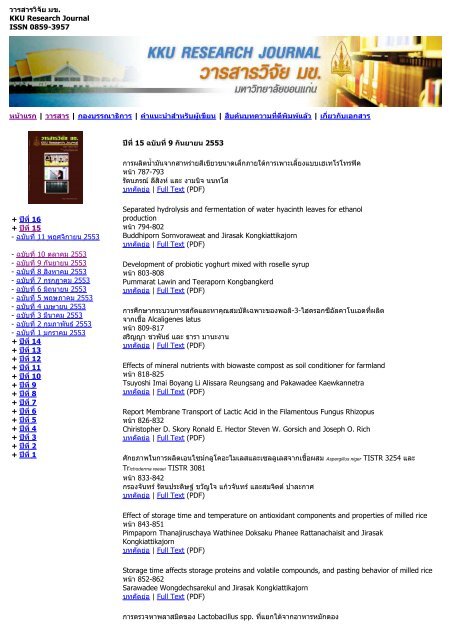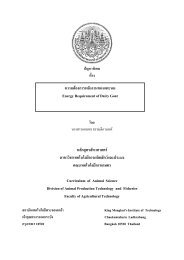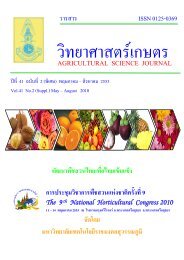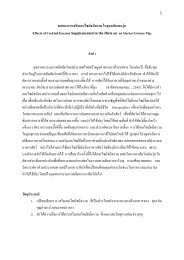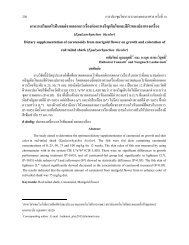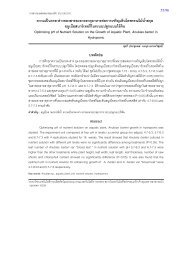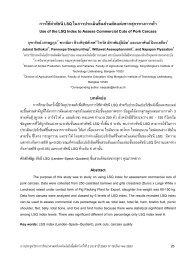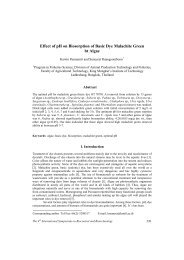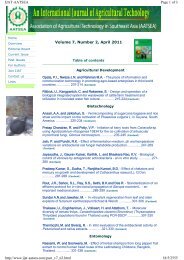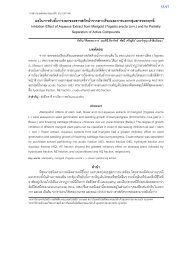53/165 เรื่อง Screening and partial characterization of bacteriocin ...
53/165 เรื่อง Screening and partial characterization of bacteriocin ...
53/165 เรื่อง Screening and partial characterization of bacteriocin ...
Create successful ePaper yourself
Turn your PDF publications into a flip-book with our unique Google optimized e-Paper software.
วารสารวิจัย มข.<br />
KKU Research Journal<br />
ISSN 0859-3957<br />
หนาแรก | วารสาร | กองบรรณาธิการ | คําแนะนําสําหรับผูเขียน<br />
| สืบคนบทความที่ตีพิมพแลว<br />
| เกี่ยวกับเอกสาร<br />
+ ปที่<br />
16<br />
+ ปที่<br />
15<br />
- ฉบับที่<br />
11 พฤศจิกายน 25<strong>53</strong><br />
- ฉบับที่<br />
10 ตุลาคม 25<strong>53</strong><br />
- ฉบับที่<br />
9 กันยายน 25<strong>53</strong><br />
- ฉบับที่<br />
8 สิงหาคม 25<strong>53</strong><br />
- ฉบับที่<br />
7 กรกฎาคม 25<strong>53</strong><br />
- ฉบับที่<br />
6 มิถุนายน 25<strong>53</strong><br />
- ฉบับที่<br />
5 พฤษภาคม 25<strong>53</strong><br />
- ฉบับที่<br />
4 เมษายน 25<strong>53</strong><br />
- ฉบับที่<br />
3 มีนาคม 25<strong>53</strong><br />
- ฉบับที่<br />
2 กุมภาพันธ 25<strong>53</strong><br />
- ฉบับที่<br />
1 มกราคม 25<strong>53</strong><br />
+ ปที่<br />
14<br />
+ ปที่<br />
13<br />
+ ปที่<br />
12<br />
+ ปที่<br />
11<br />
+ ปที่<br />
10<br />
+ ปที่<br />
9<br />
+ ปที่<br />
8<br />
+ ปที่<br />
7<br />
+ ปที่<br />
6<br />
+ ปที่<br />
5<br />
+ ปที่<br />
4<br />
+ ปที่<br />
3<br />
+ ปที่<br />
2<br />
+ ปที่<br />
1<br />
ปที่<br />
15 ฉบับที่<br />
9 กันยายน 25<strong>53</strong><br />
การผลิตนํ้ามันจากสาหรายสีเขียวขนาดเล็กภายใตการเพาะเลี้ยงแบบเฮเทโรโทรฟค<br />
หนา 787-793<br />
รัตนภรณ ลีสิงห และ งามนิจ นนทโส<br />
บทคัดยอ | Full Text (PDF)<br />
Separated hydrolysis <strong>and</strong> fermentation <strong>of</strong> water hyacinth leaves for ethanol<br />
production<br />
หนา 794-802<br />
Buddhiporn Sornvoraweat <strong>and</strong> Jirasak Kongkiattikajorn<br />
บทคัดยอ | Full Text (PDF)<br />
Development <strong>of</strong> probiotic yoghurt mixed with roselle syrup<br />
หนา 803-808<br />
Pummarat Lawin <strong>and</strong> Teeraporn Kongbangkerd<br />
บทคัดยอ | Full Text (PDF)<br />
การศึกษากระบวนการสกัดและหาคุณสมบัติเฉพาะของพอลิ-3-ไฮดรอกซีอัลคาโนเอตที่ผลิต<br />
จากเชื้อ<br />
Alcaligenes latus<br />
หนา 809-817<br />
สริญญา ชวพันธ และ ธารา มานะงาน<br />
บทคัดยอ | Full Text (PDF)<br />
Effects <strong>of</strong> mineral nutrients with biowaste compost as soil conditioner for farml<strong>and</strong><br />
หนา 818-825<br />
Tsuyoshi Imai Boyang Li Alissara Reungsang <strong>and</strong> Pakawadee Kaewkannetra<br />
บทคัดยอ | Full Text (PDF)<br />
Report Membrane Transport <strong>of</strong> Lactic Acid in the Filamentous Fungus Rhizopus<br />
หนา 826-832<br />
Chiristopher D. Skory Ronald E. Hector Steven W. Gorsich <strong>and</strong> Joseph O. Rich<br />
บทคัดยอ | Full Text (PDF)<br />
ศักยภาพในการผลิตเอนไซมกลูโคอะไมเลสและเซลลูเลสจากเชื้อผสม<br />
Aspergillus niger TISTR 3254 และ<br />
Trichoderma reesei TISTR 3081<br />
หนา 833-842<br />
กรองจันทร รัตนประดิษฐ ขวัญใจ แกวจันทร และสมจิตต ปาละกาศ<br />
บทคัดยอ | Full Text (PDF)<br />
Effect <strong>of</strong> storage time <strong>and</strong> temperature on antioxidant components <strong>and</strong> properties <strong>of</strong> milled rice<br />
หนา 843-851<br />
Pimpaporn Thanajiruschaya Wathinee Doksaku Phanee Rattanachaisit <strong>and</strong> Jirasak<br />
Kongkiattikajorn<br />
บทคัดยอ | Full Text (PDF)<br />
Storage time affects storage proteins <strong>and</strong> volatile compounds, <strong>and</strong> pasting behavior <strong>of</strong> milled rice<br />
หนา 852-862<br />
Sarawadee Wongdechsarekul <strong>and</strong> Jirasak Kongkiattikajorn<br />
บทคัดยอ | Full Text (PDF)<br />
การตรวจหาพลาสมิดของ Lactobacillus spp. ที่แยกไดจากอาหารหมักดอง
ฝายวิจัยและถายทอดเทคโนโลยี มหาวิทยาลัยขอนแกน<br />
สํานักงานอธิการบดี อาคารสิริคุณากร ชั้น<br />
5<br />
โทร. 043-203845<br />
E-mail: kkurj@kku.ac.th<br />
หนา 863-869<br />
พนิตนาฎ อูพุฒินันท<br />
ยิ่งมณี<br />
ตระกูลพัว สุมาลี พฤกษากร และนฤมล ทองไว<br />
บทคัดยอ | Full Text (PDF)<br />
<strong>Screening</strong> <strong>and</strong> <strong>partial</strong> <strong>characterization</strong> <strong>of</strong> <strong>bacteriocin</strong> from lactic acid bacteria in fish<br />
gastrointestinal tract<br />
หนา 870-877<br />
Kittaporn Rumjuankiat Komkhae Pilasombut Somchai Wangwibulkit <strong>and</strong> Adisorn Swetwiwathana<br />
บทคัดยอ | Full Text (PDF)<br />
Preliminary <strong>characterization</strong> <strong>of</strong> Lactobacillus salivarius K7 for probiotic properties<br />
หนา 878-888<br />
Thanrada Narakaew Komkhae Pilasombut Nualphan Ngamyeesoon <strong>and</strong> Adisorn Swetwiwathana<br />
บทคัดยอ | Full Text (PDF)<br />
Bacteriocin Production by Lactic Acid Bacteria Encapsulated in Calcium Alginate Beads<br />
หนา 889-896<br />
Suthasinee Nilsang<br />
บทคัดยอ | Full Text (PDF)
870 <strong>Screening</strong> <strong>and</strong> <strong>partial</strong> <strong>characterization</strong> <strong>of</strong> <strong>bacteriocin</strong> from lactic acid<br />
bacteria in fish gastrointestinal tract<br />
วารสารวิจัย มข. 15 (9) : กันยายน 25<strong>53</strong><br />
<strong>Screening</strong> <strong>and</strong> <strong>partial</strong> <strong>characterization</strong> <strong>of</strong> <strong>bacteriocin</strong> from lactic<br />
acid bacteria in fish gastrointestinal tract<br />
Kittaporn Rumjuankiat 1,2 , Komkhae Pilasombut 3 *, Somchai Wangwibulkit 3<br />
<strong>and</strong> Adisorn Swetwiwathana 4<br />
Abstract<br />
<strong>Screening</strong> <strong>and</strong> <strong>characterization</strong> <strong>of</strong> <strong>bacteriocin</strong> from lactic acid bacteria (LAB) in fish gastrointestinal tract<br />
were conducted. Four hundred isolates <strong>of</strong> LAB were screened from gastrointestinal tract <strong>of</strong> 6 fish species; Lates<br />
calcarifer (seabass), Channa striata (striped snake-head fish), Clarias batrachus (catfish), Orecochromis niloticus (nile<br />
tilapia), Barbonymus gonionotus (javanese barb) <strong>and</strong> Pangasianodon hypophthalmus (striped catfish). One effective<br />
isolate from seabass was able to produce <strong>bacteriocin</strong> <strong>and</strong> designated Sb2. Antibacterial activity test <strong>of</strong> cell free<br />
supernatant (CFS, pH 6.0) was performed against 17 bacteria target strains. CFS <strong>of</strong> Sb2 displayed growth inhibition<br />
<strong>of</strong> both spoilage <strong>and</strong> pathogenic bacteria. The maximum <strong>bacteriocin</strong> activity <strong>of</strong> 12,800 Au/ml against Lb. sakei subsp.<br />
sakei JCM 1157 T was obtained at the optimum cultivation condition <strong>of</strong> 30°C for 18 hr. Its <strong>bacteriocin</strong> activity was<br />
<strong>partial</strong>ly inhibited by proteolytic enzyme <strong>of</strong> trypsin, a-chymotrypsin <strong>and</strong> proteinase K for 50%, 75% <strong>and</strong> 96.87%,<br />
respectively. It was stable at high temperature up to 100°C for 30 min. However, its activity was reduced to 50%<br />
(from 12,800 to 6,400 Au/ml) when it was incubated at 100°C for 60 min <strong>and</strong> 4°C for 7 days. As a result <strong>of</strong> this,<br />
<strong>bacteriocin</strong> produced from Sb2 could be used as biopreservative.<br />
บทคัดย่อ<br />
การคัดแยกและศึกษาคุณสมบัติของสารแบคเทอริโอซินที่สร้างโดยแบคทีเรียกรดแลกติกจากระบบ<br />
ทางเดินอาหารของปลา โดยทำาการคัดแยกเชื้อแบคทีเรียกรดแลกติก<br />
จำานวน 400 ไอโซเลท จากปลาจำานวน 6 ชนิด ได้แก่ Lates<br />
calcarifer (seabass), Channa striata (striped snake-head fish), Clarias batrachus (catfish), Orecochromis niloticus (nile<br />
tilapia), Barbonymus gonionotus (javanese barb) และ Pangasianodon hypophthalmus (striped catfish) ซึ่งแบคทีเรีย<br />
กรดแลกติกไอโซเลท Sb2 เป็นแบคทีเรียที่คัดแยกได้จากระบบทางเดินอาหารของปลากะพงมีคุณสมบัติในการสร้าง<br />
สารแบคเทอริโอซิน ซึ่งค่ากิจกรรมของสารแบคเทอริโอซินสามารถทดสอบได้โดยนำาเฉพาะส่วนใสของอาหารเลี้ยงเชื้อ<br />
1 Agricultural Biotechnology, Faculty <strong>of</strong> Agricultural Technology, King Mongkut’s Institute <strong>of</strong> Technology Ladkrabang, Bangkok 10520, Thail<strong>and</strong><br />
2 Center for Agricultural Biotechnology (AG-BIO/PERDO-CHE) Thail<strong>and</strong><br />
3 Division <strong>of</strong> Animal Production Technology <strong>and</strong> Fisheries, Faculty <strong>of</strong> Agricultural Technology, King Mongkut’s Institute <strong>of</strong> Technology Ladkrabang,<br />
Bangkok 10520, Thail<strong>and</strong><br />
4 Division <strong>of</strong> Fermentation Technology, Faculty <strong>of</strong> Agro-Industry, King Mongkut’s Institute <strong>of</strong> Technology Ladkrabang, Bangkok 10520, Thail<strong>and</strong><br />
* Corresponding author, e-mail: kpkomkha@kmitl.ac.th
KKU Res J 15 (9) : September 2010<br />
<strong>Screening</strong> <strong>and</strong> <strong>partial</strong> <strong>characterization</strong> <strong>of</strong> <strong>bacteriocin</strong> from lactic acid<br />
bacteria in fish gastrointestinal tract<br />
871<br />
ปรับค่าความเป็นกรดและด่างเท่ากับ 6 จากนั้นนำามาทดสอบกับเชื้อแบคทีเรียเป้าหมายจำานวน<br />
17 ชนิด ผลปรากฏว่า<br />
แบคเทอริโอซินที่ผลิตโดยไอโซเลท<br />
Sb2 สามารถยับยั้งทั้งเชื้อที่ทำาให้เนื้อเน่าเสียและเชื้อก่อโรคได้<br />
โดยสามารถยับยั้ง<br />
แบคทีเรีย Lb. sakei subsp. sakei JCM 1157T ได้มากที่สุด<br />
ซึ่งมีค่ากิจกรรมการยับยั้งเท่ากับ<br />
12,800 AU/ml ไอโซเลท<br />
Sb2 สามารถสร้างสารแบคเทอริโอซินมากที่สุด<br />
เมื่อบ่มเชื้อที่อุณหภูมิ<br />
30°C เป็นเวลา 18 ชั่วโมง<br />
(12,800 AU/ml)<br />
แบคเทอริโอซินดังกล่าวถูกทำาลายด้วยเอนไซม์ trypsin, a–chymotrypsin และ proteinase K โดยคิดเป็นเปอร์เซ็นต์การถูก<br />
ทำาลายเท่ากับ 50, 75 และ 96.87% ตามลำาดับ และสามารถทนความร้อนสูงสุดที่อุณหภูมิ<br />
100 องศาเซลเซียส เป็นเวลา<br />
30 นาที เมื่อเพิ่มเวลาปรากฏว่าค่ากิจกรรมลดลงเหลือ<br />
50% และเมื่อนำาแบคเทอริโอซินไปบ่มที่อุณหภูมิ<br />
4°C เป็นเวลา<br />
7 วัน ปรากฏว่าค่ากิจกรรมลดลงเหลือ 50%<br />
คำสำคัญ: แบคทีเรียกรดแลกติก แบคเทอริโอซิน ระบบทางเดินอาหารปลา<br />
Keywords: lactic acid bacteria, <strong>bacteriocin</strong>, gastrointestinal tract, fish<br />
Introduction<br />
Lactic acid bacteria (LAB) are the natural<br />
micr<strong>of</strong>lora <strong>of</strong> many fermented food. They serve as<br />
preservative because they produce various antimicrobial<br />
compound such as organic acid, hydrogen peroxide,<br />
diacetyl (Stiles <strong>and</strong> Holzapfel, 1997; Messens <strong>and</strong> De<br />
Vuyst, 2002), antifungal compounds such as fatty acid<br />
(Corsetti et al., 1996) <strong>and</strong> <strong>bacteriocin</strong> (Klaenhammer,<br />
1993). Among the antimicrobial substances, <strong>bacteriocin</strong>s<br />
have demonstrated great potential as food preservative<br />
(Nes <strong>and</strong> Johnborg, 2004). Bacteriocins are antibacterial<br />
proteins that vary in spectrum <strong>of</strong> activity, mode <strong>of</strong> action,<br />
molecular weight, genetic origin <strong>and</strong> biochemical<br />
properties (Abee, 1995). They can kill or inhibit the<br />
growth <strong>of</strong> other bacteria (Clevel<strong>and</strong> et al., 2001).<br />
LAB have become a major source <strong>of</strong> concern<br />
for aquaculture in recent decades (Michel et al., 2007).<br />
These organisms are found on several fresh fish species,<br />
fish products, or in the intestinal content <strong>of</strong> fish (Ringø<br />
<strong>and</strong> Gatesoup, 1998). Campos et al. (2006) isolated<br />
three <strong>bacteriocin</strong>-producing LAB from the muscle <strong>of</strong><br />
turbot (Psetta maxima). All strains were identified as<br />
Lactococcus lactis subsp. lactis USC-39, Enterococcus<br />
faecium USC-46 <strong>and</strong> E. mundtii USC-51. Bacteriocin<br />
produced by three LAB strains was able to inhibit<br />
Listeria monocytogenes <strong>and</strong> Staphylococcus aureus. The<br />
aims <strong>of</strong> this study were screening <strong>and</strong> <strong>characterization</strong> <strong>of</strong><br />
<strong>bacteriocin</strong> produced by LAB isolated from gastrointestinal<br />
tract <strong>of</strong> various fish in order to use this <strong>bacteriocin</strong> as<br />
biopreservative in food industries in the future.<br />
Materials <strong>and</strong> Methods<br />
1. Isolation <strong>of</strong> LAB from fish gastrointestinal tract<br />
LAB were isolated from 6 fish species; Lates<br />
calcarifer (seabass), Channa striata (striped snake-head<br />
fish), Clarias batrachus (catfish), Orecochromis niloticus<br />
(nile tilapia), Barbonymus gonionotus (javanese barb)<br />
<strong>and</strong> Pangasianodon hypophthalmus (striped catfish).<br />
Ten grams <strong>of</strong> gastrointestinal content were homogenized<br />
in 90 ml peptone water (Merck, Germany) <strong>and</strong> 10 folds<br />
serially diluted. Subsequently, 0.1 ml <strong>of</strong> each dilution<br />
was spreaded on MRS agar (de Man-Rogosa-Sharpe;<br />
Merck, Germany) containing 0.5% CaCO 3 (Scharlau<br />
Chemie S.A., Spain) <strong>and</strong> 1% NaCl (Prolabo, Belgium)<br />
<strong>and</strong> then incubated under anaerobic condition at 37°C<br />
for 48 h. Only clear zone producing-colonies were<br />
secondly selected <strong>and</strong> stored in 30% glycerol at -80°C<br />
for further study.
872 <strong>Screening</strong> <strong>and</strong> <strong>partial</strong> <strong>characterization</strong> <strong>of</strong> <strong>bacteriocin</strong> from lactic acid<br />
bacteria in fish gastrointestinal tract<br />
2. <strong>Screening</strong> <strong>of</strong> LAB strains for antibacterial<br />
activities<br />
<strong>Screening</strong> <strong>of</strong> four hundred isolates for<br />
<strong>bacteriocin</strong> was carried out by using spot-on-lawn<br />
method (Ennahar et al., 1999). Cell-free supernatant<br />
(CFS) <strong>of</strong> <strong>bacteriocin</strong>-producing strains was obtained by<br />
centrifugation at 4,000 x g for 20 min <strong>and</strong> then adjusted<br />
to pH 6.0 by applying NaOH (to exclude the effect <strong>of</strong><br />
organic acid) before sterilization by filter (0.2 µm, Pall,<br />
U.S.A). The two layers <strong>of</strong> agar plate were prepared <strong>and</strong><br />
5 ml <strong>of</strong> s<strong>of</strong>t agar (0.8-1% agar) was added to make top<br />
layer which seeded with 10 µl <strong>of</strong> freshly grown bacterial<br />
strain (about 10 7 CFU/ml). Antibacterial activity was<br />
tested by spotting 10 µl <strong>of</strong> CFS onto the top surface <strong>of</strong><br />
agar plate. Inhibition zone was observed, after overnight<br />
incubation at proper temperature as shown in Table 1.<br />
The spectrum <strong>of</strong> CFS was expressed in an arbitrary unit<br />
(AU/ml). AU is calculated as (1000/10)D when D is the<br />
dilution factor (Parente et al., 1995).<br />
3. Optimum temperature <strong>and</strong> incubation time for<br />
maximum <strong>bacteriocin</strong> production<br />
The trial <strong>of</strong> incubation time on growth <strong>and</strong><br />
<strong>bacteriocin</strong> production from LAB was performed at 30,<br />
37 <strong>and</strong> 42°C for 24 h, each 10 ml <strong>of</strong> sample was collected<br />
from the culture every 2 h. Total plate count (CFU/ml),<br />
absorbance <strong>of</strong> bacterial turbidity at optical density (OD)<br />
<strong>of</strong> 600 nm <strong>and</strong> antibacterial activity (AU/ml) against Lb.<br />
sakei subsp. sakei JCM1157 T were examined.<br />
4. Effect <strong>of</strong> proteolytic enzyme on antibacterial<br />
activity <strong>of</strong> CFS<br />
The CFS with final concentration <strong>of</strong> 1 mg/<br />
ml <strong>of</strong> proteolytic enzyme, trypsin (Sigma, U.S.A),<br />
alpha-chymotrypsin (Sigma, U.S.A) <strong>and</strong> proteinase K<br />
(Sigma, U.S.A) at pH 7.0 was digested. Untreated sample<br />
without enzyme was used as control. All samples were<br />
sterilized by filtering through filter membrane (0.2 µm,<br />
วารสารวิจัย มข. 15 (9) : กันยายน 25<strong>53</strong><br />
Pall, U.S.A) <strong>and</strong> incubated at 37°C for 3 h. Subsequently,<br />
enzyme activity was terminated by heating at 100°C for<br />
5 min. The residual <strong>bacteriocin</strong> activity was determined<br />
by applying spot-on-lawn method against Lb. sakei<br />
subsp. sakei JCM 1157 T (Ennahar et al., 1999)<br />
5. The effect <strong>of</strong> heat <strong>and</strong> chill temperature on<br />
<strong>bacteriocin</strong> activity<br />
The study <strong>of</strong> heat stability was performed by<br />
boiling CFS (pH 6.0) at two different temperatures,<br />
100 <strong>and</strong> 121°C. At 100°C, the boiling time intervals<br />
were 5, 30 <strong>and</strong> 60 min <strong>and</strong> at 121°C was 15 min. After<br />
heating, antibacterial activity was determined by using<br />
spot-on-lawn method. The 10 day-investigation <strong>of</strong> chill<br />
temperature (4°C) on <strong>bacteriocin</strong> activity was done at<br />
0, 1, 3, 5, 7 <strong>and</strong> 10 days.<br />
Results<br />
1. Isolation <strong>and</strong> screening <strong>of</strong> <strong>bacteriocin</strong>-producing<br />
lactic acid bacteria<br />
Four hundred colonies <strong>of</strong> LAB were isolated<br />
from gastrointestinal tract <strong>of</strong> 6 fish species; Lates calcarifer<br />
(seabass; 71 isolates), Channa stiata (striped<br />
snake-head fish; 48 isolates), Clarias batrachus (catfish;<br />
91 isolates), Barbonymus gonionotus (javanese barb; 50<br />
isolates), Orcochromis niloticus (nile tilapia; 69 isolates)<br />
<strong>and</strong> Pangasianodon hypophthalmus (striped catfish;<br />
71 isolates). These isolates were investigated for their<br />
antibacterial activity with cell free supernatant (CFS),<br />
which eliminated acid condition by adjusting pH 6.0,<br />
against 17 bacteria strains. Only one isolate taken<br />
from seabass implied to produce <strong>bacteriocin</strong> <strong>and</strong> was<br />
later designed as Sb2 (Table 1). CFS <strong>of</strong> Sb2 displayed<br />
antibacterial activity against both gram positive <strong>and</strong><br />
gram negative bacteria as shown in Table 2. The highest<br />
antibacterial activity <strong>of</strong> 12,800 Au/ml was found on
KKU Res J 15 (9) : September 2010<br />
Lb. sakei subsp. sakei JCM 1157 T . In addition, CFS<br />
<strong>of</strong> Sb2 exhibited antibacterial activity against both<br />
pathogenic bacteria such as S. aureus TISTR118 <strong>and</strong><br />
spoilage bacteria in meat such as Leuc. mesenteroides<br />
<strong>Screening</strong> <strong>and</strong> <strong>partial</strong> <strong>characterization</strong> <strong>of</strong> <strong>bacteriocin</strong> from lactic acid<br />
bacteria in fish gastrointestinal tract<br />
873<br />
subsp. mesenteroides JCM 6124 T , Br. campestris NBRC<br />
11547 T , P. fluorescens JCM 5963 T , L. innocua ATCC<br />
33090 T <strong>and</strong> B. coagulans JCM 2257 T .<br />
Table 1. Isolation <strong>of</strong> <strong>bacteriocin</strong>-producing LAB from gastrointestinal tract <strong>of</strong> 6 fish species<br />
Table 2. Antibacterial activity <strong>of</strong> isolate Sb2 against bacteria strains
874 <strong>Screening</strong> <strong>and</strong> <strong>partial</strong> <strong>characterization</strong> <strong>of</strong> <strong>bacteriocin</strong> from lactic acid<br />
bacteria in fish gastrointestinal tract<br />
2. Pr<strong>of</strong>ile <strong>of</strong> growth <strong>and</strong> <strong>bacteriocin</strong> production <strong>of</strong><br />
isolate Sb2<br />
The growth condition <strong>of</strong> isolate Sb2 <strong>and</strong><br />
<strong>bacteriocin</strong> production were examined at various<br />
temperatures: 30, 37 <strong>and</strong> 42°C as shown in Figure.1 A, B<br />
<strong>and</strong> C. The cell number <strong>and</strong> optical density value at 600<br />
nm revealed the same trend <strong>of</strong> growth. The maximum<br />
วารสารวิจัย มข. 15 (9) : กันยายน 25<strong>53</strong><br />
<strong>bacteriocin</strong> production (12,800 AU/ml) was observed<br />
at 30°C for 18 h. While at 37°C or 42°C <strong>bacteriocin</strong><br />
productions were lower (6400 <strong>and</strong> 1600 AU/ml,<br />
respectively). Therefore, the optimum growth condition<br />
for maximum <strong>bacteriocin</strong> production <strong>of</strong> isolate Sb2 was<br />
at 30°C for 18 h. (OD value = 0.8).<br />
Figure 1. Growth pr<strong>of</strong>ile <strong>of</strong> Sb2 <strong>and</strong> <strong>bacteriocin</strong> production at various temperatures, A) Pr<strong>of</strong>ile <strong>of</strong> growth <strong>of</strong> Sb2<br />
<strong>and</strong> <strong>bacteriocin</strong> production at 30°C, B) Pr<strong>of</strong>ile <strong>of</strong> growth <strong>of</strong> Sb2 <strong>and</strong> <strong>bacteriocin</strong> production at 37°C, C)<br />
Pr<strong>of</strong>ile <strong>of</strong> growth <strong>of</strong> Sb2 <strong>and</strong> <strong>bacteriocin</strong> production at 42°C
KKU Res J 15 (9) : September 2010<br />
3. Effect <strong>of</strong> proteolytic enzyme<br />
Characterization <strong>of</strong> CFS by proteolytic enzyme<br />
showed a decline <strong>of</strong> antimicrobial activity when<br />
digestion by trypsin, a-chymotrypsin <strong>and</strong> proteinase<br />
<strong>Screening</strong> <strong>and</strong> <strong>partial</strong> <strong>characterization</strong> <strong>of</strong> <strong>bacteriocin</strong> from lactic acid<br />
bacteria in fish gastrointestinal tract<br />
875<br />
K. The remaining antimicrobial activities were 3,200,<br />
400 <strong>and</strong> 200 AU/ml, respectively, while the control<br />
treatment was 6,400 AU/ml, as shown in Table 3.<br />
Table 3. Effect <strong>of</strong> proteolytic enzyme on the antibacterial activity <strong>of</strong> Sb2 isolate against L. sakei subsp. sakei JCM<br />
1157 T<br />
4. Effects <strong>of</strong> heat <strong>and</strong> chill temperature on <strong>bacteriocin</strong><br />
activity <strong>of</strong> CFS<br />
Bacteriocin activity was stabilized for 30<br />
min at 100ºC. At 60 min incubation time, the activity<br />
reduced by 50% (from 12,800 to 6,400 AU/ml). In<br />
addition, <strong>bacteriocin</strong> produced from Sb2 could tolerate<br />
up to 121ºC for at least 15 min (the activity was reduced<br />
from 12,800 to 3,200 Au/ml; as shown in Table 4). The<br />
<strong>bacteriocin</strong> was able to stable in chill temperature (4ºC)<br />
up to 5 days (12,800 AU/ml). Its activity gradually<br />
decreased to 50% after storing at 4°C for 7 day (6400<br />
AU/ml) <strong>and</strong> decreased to 25% at day 10 (3,200 Au/ml).<br />
Table 4. Effects <strong>of</strong> heat <strong>and</strong> chill temperature on <strong>bacteriocin</strong> activity <strong>of</strong> Sb2 against L. sakei subsp. sakei JCM<br />
1157 T
876 <strong>Screening</strong> <strong>and</strong> <strong>partial</strong> <strong>characterization</strong> <strong>of</strong> <strong>bacteriocin</strong> from lactic acid<br />
bacteria in fish gastrointestinal tract<br />
Discussion<br />
Even through several studies addressing<br />
the <strong>bacteriocin</strong>-producing LAB isolated from dairy,<br />
meat products <strong>and</strong> fish products, only few <strong>bacteriocin</strong>s<br />
isolated from fresh fish have been reported (Campos<br />
et al., 2006). The main objectives <strong>of</strong> this study were to<br />
screen <strong>and</strong> <strong>characterization</strong> <strong>of</strong> <strong>bacteriocin</strong> produced by<br />
LAB from gastrointestinal tract <strong>of</strong> fish. One isolate <strong>of</strong> a<br />
total <strong>of</strong> 400 LAB was able to produced <strong>bacteriocin</strong> against<br />
Lb. plantarum ATCC 14917, Lb. sakei subsp. sakei JCM<br />
1157 T , Lb. sakei TISTR 890, Lc. lactis subsp. cremoris<br />
TISTR 1344, Leuc. mesenteroides subsp. mesenteroides<br />
JCM 6124 T , Leuc. mesenteroides TISTR 942, B. coagulans<br />
JCM 2257 T , L. innocua ATCC 33090, Br. campestris<br />
NBRC 11547, P. fluorescens JCM 5693 T , P. fluorescens<br />
TISTR 358, E. faecalis JCM 5803 T , E. faecalis TISTR<br />
888, S. aureus TISTR 118 <strong>and</strong> Streptococcus sp. TISTR<br />
1030. The maximum <strong>bacteriocin</strong> production (12,800<br />
AU/ml) was observed at 30°C for 18 hr. Campos et<br />
al. (2006) isolated three <strong>bacteriocin</strong>-producing LAB,<br />
(Lc. lactis ssp. lactis USC-39, E. faecium USC-46 <strong>and</strong><br />
E. mundtii USC-51). It was found that Lc. lactis ssp.<br />
lactis USC-39 exhibited the maximum antimicrobial<br />
activity against L. monocytogenes LHICA 1112 after<br />
33 hr at 30ºC <strong>of</strong> incubation. In addition, antimicrobial<br />
activity displayed maximum inhibitory activity against<br />
S. aureus LHICA 1010 after 21 hr at 30ºC <strong>of</strong> incubation.<br />
While, the highest <strong>bacteriocin</strong> production by E. faecium<br />
USC-46 against L. monocytogenes LHICA 1112 <strong>and</strong><br />
S. aureus ATCC 35845 was observed after 21 hr at<br />
30ºC. Moreover, <strong>bacteriocin</strong> production by E. mundtii<br />
USC-51 showed maximum inhibitory activity against<br />
L. monocytogenes <strong>and</strong> S. aureus after 46–55 hr <strong>and</strong> 21<br />
hr at 30ºC <strong>of</strong> incubation, respectively.<br />
The CFS <strong>of</strong> Sb2 was found to be sensitive to<br />
proteolytic enzymes that indicated the <strong>bacteriocin</strong> was<br />
วารสารวิจัย มข. 15 (9) : กันยายน 25<strong>53</strong><br />
proteinaceous structure (Klaenhammer, 1988; Vaughan<br />
et al., 2001). Its <strong>bacteriocin</strong> activity was <strong>partial</strong>ly<br />
inhibited by trypsin, a-chymotrypsin <strong>and</strong> proteinase<br />
K. However, Campos et al. (2006) reported that<br />
antimicrobial activities <strong>of</strong> Lc. lactis ssp. lactis USC-39,<br />
E. faecium USC-46 <strong>and</strong> E. mundtii USC-51 were<br />
sensitive to the action <strong>of</strong> proteinase K. In addition,<br />
<strong>bacteriocin</strong> <strong>of</strong> Sb2 was able to tolerate when subjected to<br />
thermal treatment at 100ºC <strong>and</strong> chill temperature (4ºC)<br />
for 10 days. These experimental results have shown<br />
the similar trend to another research done by Campos<br />
et al. (2006) who reported that <strong>bacteriocin</strong> activity <strong>of</strong><br />
Lc. lactis ssp. lactis USC-39, E. faecium USC-46 <strong>and</strong><br />
E. mundtii USC-51 was stable in thermal treatment at<br />
100ºC <strong>and</strong> even stored at 4ºC for 21 days. As a result,<br />
<strong>bacteriocin</strong> produced by Sb2 could be applied to use as<br />
biopreservative in food industry.<br />
Conclusion<br />
Bacteriocin-producing lactic acid bacteria<br />
Sb2 isolated from seabass gastrointestinal tract. Cell<br />
free supernatant (CFS) <strong>of</strong> Sb2 displayed antibacterial<br />
activity against Lb. plantarum ATCC 14917 T , Lb. sakei<br />
subsp. sakei JCM 1157 T , Lb. sakei TISTR 890, Lc. lactis<br />
subsp. cremoris TISTR 1344, Leuc. mesenteroides<br />
subsp. mesenteroides JCM 6124 T , Leuc. mesenteroides<br />
subsp. mesenteroides TISTR 942, E. faecalis TISTR<br />
888, E. faecalis JCM 5803 T , Streptococcus sp. TISTR<br />
1030, B. coagulans JCM 2257 T , L. innocua ATCC<br />
33090 T , Br. campestris NBRC 11547 T S. aureus TISTR<br />
118, P. fluorescens JCM 5963 T <strong>and</strong> Pseudomonas<br />
fluorescens TISTR 358. The CFS <strong>of</strong> Sb2 was sensitive<br />
to proteolytic enzymes, indicated that <strong>bacteriocin</strong><br />
was proteinaceous structure. Therefore, <strong>bacteriocin</strong><br />
produced from Sb2 could be used as biopreservative.
KKU Res J 15 (9) : September 2010<br />
Acknowledgements<br />
This research is <strong>partial</strong>ly supported by i) the<br />
Center for Agricultural Biotechnology, Postgraduate<br />
Education <strong>and</strong> Research Development Office,<br />
Commission on Higher Education, Ministry <strong>of</strong><br />
Education. ii) Meat Technology Research Network<br />
Center <strong>of</strong> King Mongkut’s Institute <strong>of</strong> Technology<br />
Ladkrabang on corresponding between King Mongkut’s<br />
Institute <strong>of</strong> Technology Ladkrabang <strong>and</strong> the Thail<strong>and</strong><br />
Research Fund.<br />
References<br />
Abee, T. 1995. Pore-forming <strong>bacteriocin</strong>s <strong>of</strong> gram-<br />
positive bacteria <strong>and</strong> self-protection<br />
mechanisms <strong>of</strong> producer organisms. FEMS<br />
Microbiology Letters 129: 1-10.<br />
Campos, C.A., Rodríguez, Ó., Calo-Mata, P., Prado,<br />
M. <strong>and</strong> Barrops-Velázquez, J. 2006. Preliminary<br />
<strong>characterization</strong> <strong>of</strong> <strong>bacteriocin</strong> from<br />
Lactococcus lactis, Enterococcus faecium <strong>and</strong><br />
Enterococcus munditii strains isolated from<br />
turbot (Psetta maxima). Food Research<br />
International 39: 356-364.<br />
Clevel<strong>and</strong>, J., Montville, T.J., Nes, I.F. <strong>and</strong> Chikindas,<br />
M.L. 2001. Bacteriocins: safe, natural antimicrobials<br />
for food preservation. International<br />
Journal <strong>of</strong> Food Microbiology 71: 1-20.<br />
Corsetti A., Gobbetti, M. <strong>and</strong> Smacchi, E. 1996.<br />
Antibacterial activity <strong>of</strong> sourdough lactic acid<br />
bacteria:isolation <strong>of</strong> <strong>bacteriocin</strong>-like inhibitory<br />
substance from Lactobacillus sanfrancisco<br />
C57. Food Microbiology 13: 447-456.<br />
Ennahar, S., Sonomoto, K. <strong>and</strong> Ishizaki, A. 1999. Class<br />
IIa <strong>bacteriocin</strong>s from Food Preservation.<br />
Journal <strong>of</strong> Bioscience <strong>and</strong> Bioengineering<br />
6: 705-716.<br />
<strong>Screening</strong> <strong>and</strong> <strong>partial</strong> <strong>characterization</strong> <strong>of</strong> <strong>bacteriocin</strong> from lactic acid<br />
bacteria in fish gastrointestinal tract<br />
877<br />
Klaenhammer, T.R. 1988. Bacteriocins <strong>of</strong> lactic acid<br />
bacteria. Biochemie 70 : 337-349.<br />
Klaenhammer, T.R. 1993. Genetics <strong>of</strong> <strong>bacteriocin</strong>s<br />
produced by lactic acid bacteria. FEMS<br />
Microbiology Review 12: 39-85.<br />
Messens, W. <strong>and</strong> De Vuyst, L. 2002. Inhibitory<br />
substances produced by Lactobacilli isolated<br />
from sourdoughs. International Journal <strong>of</strong><br />
Food Microbiology 72: 31-43.<br />
Michel, C., Pelletier, C., Boussaha, M., Douet, D.G.,<br />
Lautraite, A. <strong>and</strong> Tailliez, P. 2007.. Diversity<br />
<strong>of</strong> lactic acid bacteria associated with fish<br />
<strong>and</strong> the fish farm environment, established<br />
by amplified rRNA gene restriction analysis.<br />
Applied <strong>and</strong> Environmental Microbiology<br />
73: 2947-2955.<br />
Nes, I.F. <strong>and</strong> Johnsborg, O. 2004. Exploration <strong>of</strong> antimicrobial<br />
potential in LAB by genomics. Current<br />
Opinion in Biotechnology 15: 100-104.<br />
Parente, E., Brienza, C., Moles, M. <strong>and</strong> Ricciardi,<br />
A. 1995. A comparison <strong>of</strong> methods for the<br />
measurement <strong>of</strong> <strong>bacteriocin</strong> activity. Journal<br />
<strong>of</strong> Microbiological Methods 22: 95-108<br />
Ringø, E. <strong>and</strong> Gatesoup, F.J. 1998. Lactic acid bacteria<br />
in fish: a review. Aquaculture 160: 177-203.<br />
Stiles, M.E. <strong>and</strong> Holzapfel, W.H. 1997. Lactic acid<br />
bacteria <strong>of</strong> foods <strong>and</strong> their current taxonomy.<br />
International Journal <strong>of</strong> Food Microbiology<br />
36: 1-29.<br />
Vaughan, A., Eijsink, V.G.H., O’Sullivan, T.E.,<br />
O’Hanlon, K. <strong>and</strong> Van Sinderen, D. 2001.<br />
An analysis <strong>of</strong> <strong>bacteriocin</strong>s produced by<br />
lactic acid bacteria isolated from malted<br />
barley. Journal <strong>of</strong> Applied Microbiology<br />
91: 131-138.


